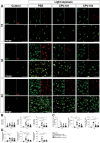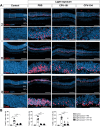Moss-derived human complement factor H modulates retinal immune response and attenuates retinal degeneration
- PMID: 40217267
- PMCID: PMC11992837
- DOI: 10.1186/s12974-025-03418-2
Moss-derived human complement factor H modulates retinal immune response and attenuates retinal degeneration
Abstract
Background: AMD is a multifactorial progressive disease of the central retina that leads to severe vision loss among the elderly. Genome-wide association studies in AMD patients and preclinical data have identified a dysregulated complement system and aberrant microglia responses in the pathogenesis of AMD. Specifically, a genetic variant in the complement factor H (CFH) gene, an important inhibitor of the alternative complement pathway, confers the strongest risk for AMD. Here, we investigated whether moss-derived recombinant human CFH proteins, termed CPV-101 and CPV-104, can modulate microglia reactivity and limit retinal degeneration in a murine light damage paradigm mimicking important features of AMD.
Methods: Two glycosylated human recombinant CFH proteins CPV101, and CPV-104 were produced in moss suspension cultures. In addition, glycans of the CPV-104 variant are sialylated, an optimization that makes CPV-104 an analog of human CFH. BALB/cJ mice received intravitreal injections of 5 µg CPV-101 and CPV-104 or vehicle, starting 1 day prior to exposure to 10,000 lx white light for 30 min. The effects of CPV-101 and CPV-104 treatment on mononuclear phagocyte and Müller cell reactivity were analyzed by immunostainings of retinal sections and flat mounts. Gene expression of microglia markers was analyzed using quantitative real-time PCR (qRT-PCR). Optical coherence tomography (OCT); Blue Peak Autofluorescence (BAF); terminal deoxynucleotidyl transferase dUTP nick end labeling (TUNEL) staining, and morphometric analyses were used to quantify the extent of retinal degeneration and photoreceptor apoptosis.
Results: Light-exposed mice treated with moss-derived recombinant human full-length CFH showed reduced complement activation and MAC deposition in the retina. Concomitantly, mononuclear phagocyte and Müller cell reactivity in light-exposed retinas were also ameliorated upon CFH substitution. Moreover, attenuated light-induced retinal degeneration was detected in mice that received moss-derived CFH.
Conclusion: Modulating the alternative complement pathway using moss-derived recombinant human full-length CFH variant CPV-101 and CPV-104 counter-regulate gliosis and attenuates light-induced retinal degeneration, highlighting a promising concept for the treatment of AMD patients.
Keywords: CPV-101; CPV-104; Complement factor H; Light damage; Microglia; Moss-derived recombinant CFH; Retinal degeneration.
© 2025. The Author(s).
Conflict of interest statement
Declarations. Ethical approval and consent to participate: All animal experiments were reviewed and approved by the government office responsible for animal welfare in North-Rhine-Westphalia (Landesamt für Natur, Umwelt und Verbraucherschutz, Application No. 81-02.04.2021.A277). All experimental procedures complied with the German law on animal protection and the ARVO Statement for the Use of Animals in Ophthalmic and Vision Research. Consent for publication: Not applicable. Competing interests : Paulina Dabrowska-Schlepp, Andreas Busch and Andreas Schaaf are employees of Eleva GmbH and are co-authors of a patent for recombinant CFH (CPV-104).
Figures





Similar articles
-
Targeting translocator protein (18 kDa) (TSPO) dampens pro-inflammatory microglia reactivity in the retina and protects from degeneration.J Neuroinflammation. 2015 Nov 2;12:201. doi: 10.1186/s12974-015-0422-5. J Neuroinflammation. 2015. PMID: 26527153 Free PMC article.
-
Minocycline counter-regulates pro-inflammatory microglia responses in the retina and protects from degeneration.J Neuroinflammation. 2015 Nov 17;12:209. doi: 10.1186/s12974-015-0431-4. J Neuroinflammation. 2015. PMID: 26576678 Free PMC article.
-
Genetic targeting or pharmacological inhibition of galectin-3 dampens microglia reactivity and delays retinal degeneration.J Neuroinflammation. 2022 Sep 17;19(1):229. doi: 10.1186/s12974-022-02589-6. J Neuroinflammation. 2022. PMID: 36115971 Free PMC article.
-
Modulation of three key innate immune pathways for the most common retinal degenerative diseases.EMBO Mol Med. 2018 Oct;10(10):e8259. doi: 10.15252/emmm.201708259. EMBO Mol Med. 2018. PMID: 30224384 Free PMC article. Review.
-
Targeting the complement system for the management of retinal inflammatory and degenerative diseases.Eur J Pharmacol. 2016 Sep 15;787:94-104. doi: 10.1016/j.ejphar.2016.03.001. Epub 2016 Mar 3. Eur J Pharmacol. 2016. PMID: 26948311 Free PMC article. Review.
References
-
- Nowak JZ. Age-related macular degeneration (AMD): pathogenesis and therapy. Pharmacol Rep. 2006;58:353–63. - PubMed
-
- Chakravarthy U, Augood C, Bentham GC, de Jong PT, Rahu M, Seland J, Soubrane G, Tomazzoli L, Topouzis F, Vingerling JR, et al. Cigarette smoking and age-related macular degeneration in the EUREYE Study. Ophthalmology. 2007;114:1157–63. - PubMed
-
- Chapman NA, Jacobs RJ, Braakhuis AJ. Role of diet and food intake in age-related macular degeneration: a systematic review. Clin Exp Ophthalmol. 2019;47:106–27. - PubMed
-
- Rudnicka AR, Kapetanakis VV, Jarrar Z, Wathern AK, Wormald R, Fletcher AE, Cook DG, Owen CG. Incidence of late-stage age-related macular degeneration in American Whites: systematic review and meta-analysis. Am J Ophthalmol. 2015;160(85–93): e83. - PubMed
MeSH terms
Substances
LinkOut - more resources
Full Text Sources
Miscellaneous

